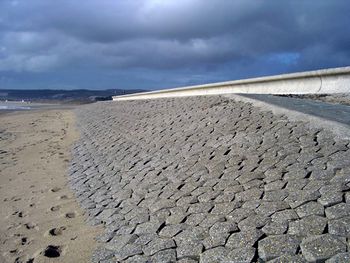Revetments
The following article discusses the fixing of the coastline by revetments.
Contents
Method
Revetments can be an exposed structure as well as a buried structure.
Exposed revetments
Revetments are always made as sloping structures and are often constructed as permeable rubble mound structures using natural stones or concrete blocks. Rubble mound armoring enhances wave energy absorption and minimizes reflection and wave run-up.
However, revetments can also consist of different kinds of pattern-placed natural blocks (e.g. basalt columns), concrete slabs, some of them permeable and interlocking. In this way their functionality is increased in terms of absorption and strength.
Net mesh stone-filled mattresses, such as gabions, are also used; however, they are only recommended for use at fairly protected locations.
Revetments can also consist of sand-filled geotextile fabric bags, mattresses and tubes. Such structures must be protected against UV-light to avoid weathering of the fabric. Sand-bagging is often used as emergency protection. Geotextile fabric revetments are fragile against mechanical impact and vandalism, and their appearance is not natural.
Buried revetments

A buried revetment can be constructed as part of a soft protection, e.g. as a hard emergency protection built into a strengthened dune which acts as shore protection and/or sea defence.
Functional characteristics
All types of revetments have the inherent function of beach degradation as they are used at locations where the coast is exposed to erosion. A revetment will fix the location of the coastline, but it will not arrest the ongoing erosion in the coastal profile, and the beach in front of the revetment will gradually disappear. However, as a revetment is often made as a permeable, sloping structure, it will normally not accelerate the erosion, as did seawalls; on the contrary, rubble revetments are often used as reinforcement for seawalls which have been exposed due to the disappearance of the beach. Such reinforcement protects the foot of the seawall and minimizes the reflection.
A revetment, like a seawall, will decrease the release of sediments from the section it protects, for which reason it will have a negative impact on the sediment budget along adjacent shorelines.
Stability of pattern-placed revetments
Pattern-placed revetments generally consist of three components: the top layer, the filter layer, and the filling between the elements (referred to as joint filling). The top layer is the most important component, typically composed of arranged elements made of natural stone or concrete. These elements can be broadly classified as blocks or columns. While blocks are rectangular and tightly arranged, columns are irregular. The open spaces between the columns are typically filled with joint filling to enhance clamping. Also, in accordance with their name, columns generally have a larger height-over-width ratio than blocks, which is beneficial for their stability (Fig. 3).
The hydraulic stability of a revetment depends on the magnitude of the hydraulic loading (wave height, wave length), on the slope of the revetment and the thickness and density of the top layer. The major failing mechanisms are deformation and wash-out of joint filling. Deformation occurs when the filter material migrates down the slope, causing variations in the filter layer thickness. This can occur when the wave impact lifts the columns (slightly) from the filter layer. Washed-out of the joint filling can be caused by repeated wave loading that washes out the granular material between the columns. This reduction in joint filling negatively affects clamping of the columns which can be lifted more easily from the filter layer. The complete removal of a column has a limited immediate effect on the hydraulic stability if there is no other (structural) damage. [2]
The stability of rubble mound revetments is discussed in the article Stability of rubble mound breakwaters and shore revetments.
Applicability
A revetment is a passive structure, which protects against erosion caused by wave action, storm surge and currents. The main difference in the function of a seawall and a revetment is that a seawall protects against erosion and flooding, whereas a revetment only protects against erosion. A revetment is thus a passive coastal protection measure and is used at locations exposed to erosion or as a supplement to seawalls or dikes at locations exposed to both erosion and flooding. Revetments are used on all types of coasts.
Rubble revetments and similar structures have a permeable and fairly steep slope; normally a 1:2 slope is used. This slope is suitable neither for recreational use nor for the landing or hauling of small fishing boats. Consequently, this kind of structure should not be used at locations, where the beach is used for recreation or fishing activities. For such locations, other types of protection measures must be considered, but if a revetment is required, a more gently sloping structure with a smooth surface is recommended.
References
- ↑ Danish Coastal Authority, 1998. "Menneske, Hav, Kyst og Sand". (in Danish), (Man, Sea Coast and Sand in English). Kystinspektoratet 1973-1998.
- ↑ van der Vegt, N., Klerk, W.J., Peters, D.J., van Gent, M.R.A. and Hofland, B. 2024. Estimating the effect of assumed initial damage to the hydraulic stability of pattern-placed revetments on dikes using finite element modeling. Coastal Engineering 189, 104484
Related articles
- Seawalls and revetments
- Stability of rubble mound breakwaters and shore revetments
- Hard coastal protection structures
Further reading
- Mangor, K., Drønen, N. K., Kaergaard, K.H. and Kristensen, N.E. 2017. Shoreline management guidelines. DHI https://www.dhigroup.com/marine-water/ebook-shoreline-management-guidelines
Please note that others may also have edited the contents of this article.
|

